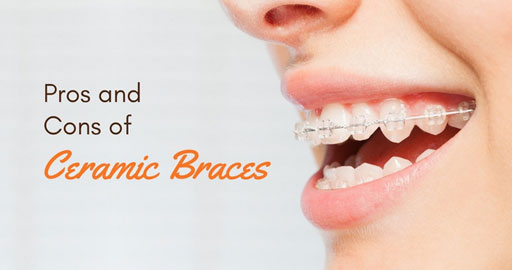
The Pros and Cons of Ceramic Braces
Ceramic braces are one of the leading orthodontic treatment choices available today. They offer the combination of:
- Efficiency and working principle of traditional braces with
- Comfort and reduced visibility
But before concluding, which option suits you the most? Keep reading to let the experts at Clove give you a rundown of the pros and cons of ceramic braces.
What are Clear Ceramic Braces?
Clear Ceramic braces offer a more discrete alternative to metal appliances. Clear ceramic braces are efficient in addressing various dental issues, such as:
- Misalignment of the jaws
- Crooked teeth
- Spacing problems and many other orthodontic problems.
How do you know if you’re a good candidate for ceramic braces?
Ceramic braces are recommended when permanent teeth erupt into the oral cavity and reach maximum growth. This ensures a faster treatment with a lower chance of brackets breaking due to tooth movement.
Because they are tooth-colored and generally blend in, they are a subtle orthodontic option. This makes them ideal for individuals with full-time jobs or who are attending college, as they do not attract attention.
Pros of Ceramic Braces
- Reduced Visibility: Given their use of translucent or tooth-colored material, achieved via ceramic or porcelain, they tend to blend in with your teeth. Thus giving a much more natural appearance, making them a preferred choice for individuals looking for a subtler orthodontic option.
- Efficient Straightening: Ceramic braces’ mechanism is the same as that of metal braces. It’s effective in misalignments, overcrowding, and bite issues correction.
- Predictable Results: They provide reliable results and can address many orthodontic problems.
- Smooth Surfaces: They tend to have smoother designs thus reducing irritation and discomfort.
- Less Impact on Gums: Their design can be gentler on the gums and cheeks than traditional braces.
Cons of Ceramic Braces:
- Ceramic braces: marketed as being less visible for an pleasing look, are still visible.
- Extra precautions necessary: Because of the material used, ceramic braces tend to be fragile compared with metal braces. To prevent damage, experts suggest avoiding certain foods or activities.
- Higher Cost: Due to their delicate material, Ceramic braces are found to be more expensive than traditional metal braces, making them less accessible for some individuals.
- Staining: While being better stain resistant, they still discolor over time without proper Care.
Conclusion
Ceramic braces are an excellent alternative for people with more discrete treatment needs. But the factors for consideration include:
- Potential fragility
- Cost
- Maintenance
- Orthodontic consultation to determine if they align with your dental needs and lifestyle.
Remember, regardless of the type of braces chosen, maintaining good oral hygiene and following orthodontist recommendations are crucial to achieving the desired results.
Leave a Reply
Leave a Reply
Explore More Similar Posts
Explore More Blogs


Leave a Reply